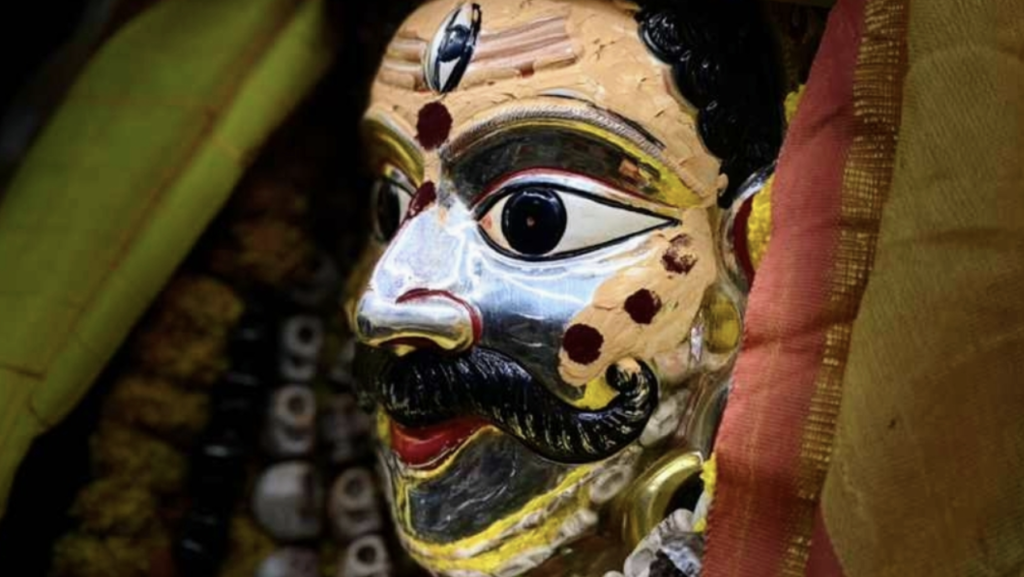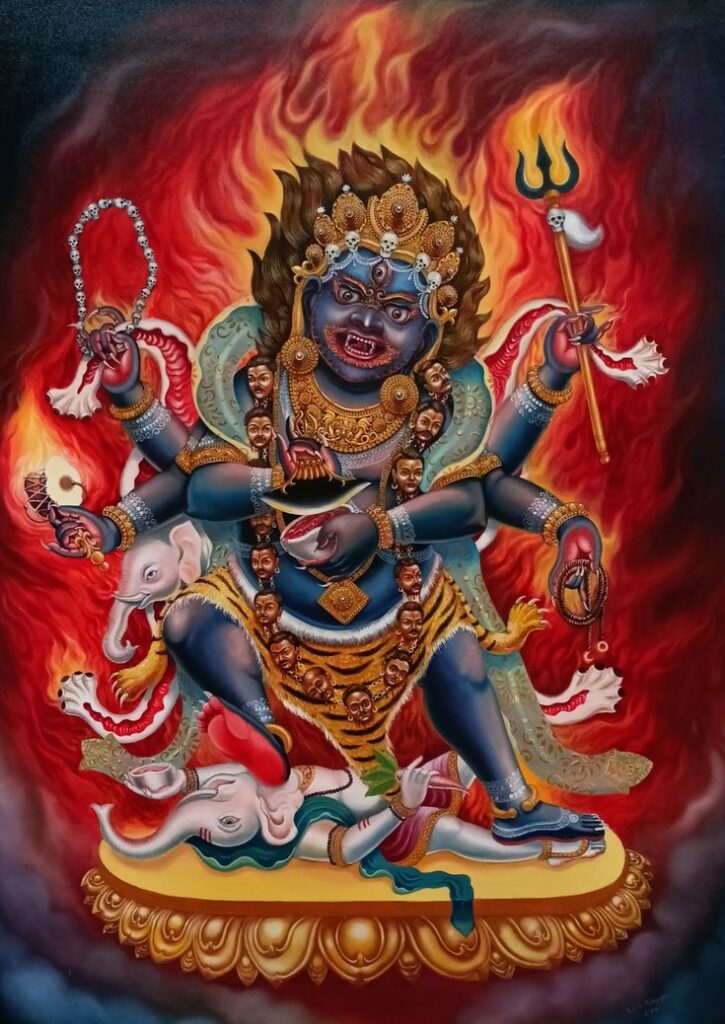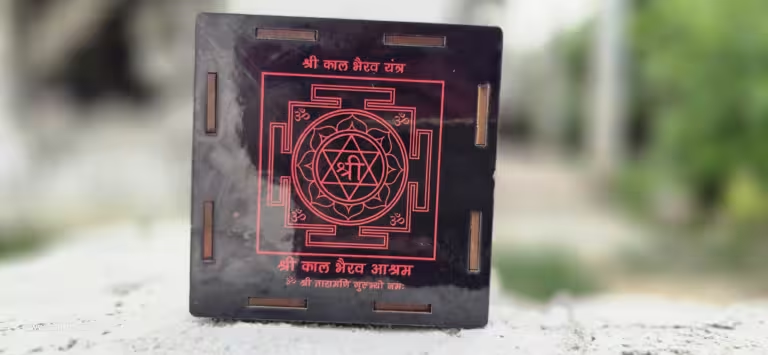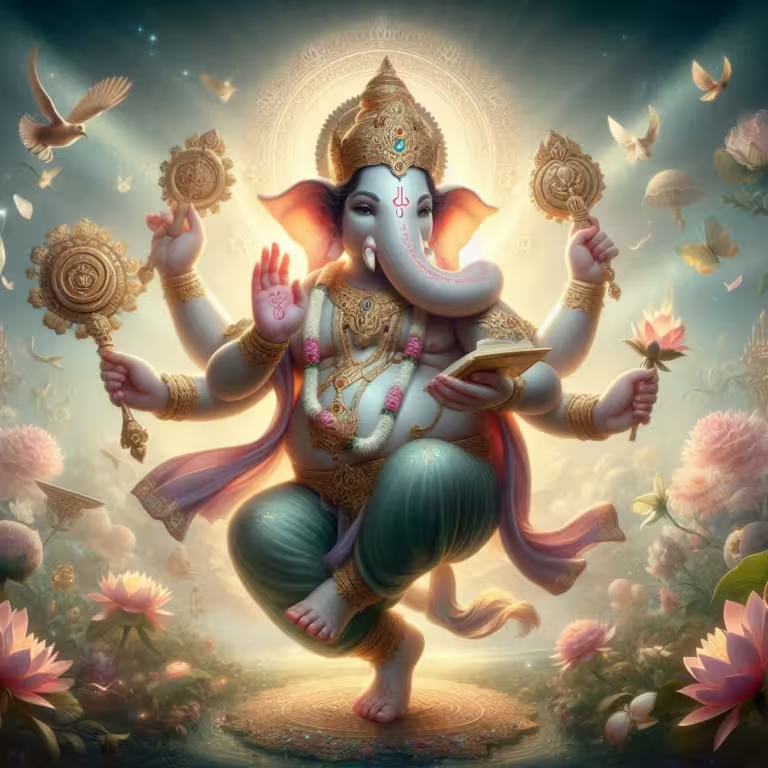Kaal Bhairava Ashtakam is a revered Sanskrit hymn dedicated to Lord Kaal Bhairava, the fierce manifestation of Lord Shiva. Composed by the great saint Adi Shankaracharya, this hymn holds a special place in the hearts of devotees. It extols the virtues and powers of Kaal Bhairava, the guardian deity of Kashi (Varanasi), who is revered for his ability to destroy fear, ignorance, and negativity.
Table of Contents
- Introduction to Kaal Bhairava Ashtakam
- Interpretation of Kaal Bhairava Ashtakam
- Verse 1: The Protector of Kashi
- Verse 2: The Radiant One
- Verse 3: The Fierce and Compassionate Lord
- Verse 4: The Granter of Worldly and Spiritual Boons
- Verse 5: The Upholder of Dharma
- Verse 6: The Fearsome Liberator
- Verse 7: The Destroyer of Sin
- Verse 8: The Ancient Lord of the Universe
- The Connection with Adi Shankaracharya
- Benefits of Reciting Kaal Bhairava Ashtakam
- Conclusion
1. Introduction to Kaal Bhairava Ashtakam
Kaal Bhairava Ashtakam is a powerful hymn that venerates Lord Kaal Bhairava, the fierce protector and ruler of time. He is depicted as a fierce deity, often adorned with skulls and serpents, embodying the destructive aspect of Lord Shiva. This hymn, composed by Adi Shankaracharya, is chanted by devotees to seek protection, dispel fear, and attain spiritual liberation.
2. Interpretation of Kaal Bhairava Ashtakam
Each verse of the Kaal Bhairava Ashtakam is rich in symbolism and meaning. Here is a deeper look into the verses:
Verse 1: The Protector of Kashi
देवराजसेव्यमानपावनांघ्रिपङ्कजं
व्यालयज्ञसूत्रमिन्दुशेखरं कृपाकरम् ।
नारदादियोगिवृन्दवन्दितं दिगंबरं
काशिकापुराधिनाथकालभैरवं भजे ॥१॥
Translation:
“Greetings to Lord Kalabhairava, the supreme deity of Kashi. His lotus feet are honored by Lord Indra, the king of the gods. He wears a snake as his sacred thread and has the moon adorning his head, radiating immense compassion. Praised by the divine sage Narada and other yogis, he is a Digambara, clothed in the sky, embodying absolute freedom.”
Interpretation:
This verse glorifies Kaal Bhairava as the protector of Kashi, whose divine presence is honored by the gods themselves. His attributes, such as the snake (symbolizing time) and the moon (symbolizing the mind), depict his control over time and consciousness.
Verse 2: The Radiant One
भानुकोटिभास्वरं भवाब्धितारकं परं
नीलकण्ठमीप्सितार्थदायकं त्रिलोचनम् ।
कालकालमंबुजाक्षमक्षशूलमक्षरं
काशिकापुराधिनाथकालभैरवं भजे ॥२॥
Translation:
“Greetings to Lord Kalabhairava, the supreme lord of Kashi, who shines with the brilliance of a million suns and liberates devotees from the cycle of rebirths. He is the ultimate, with a blue throat, who fulfills our desires, and has three eyes. He is the conqueror of death, with eyes resembling lotuses. His trident sustains the world, and he is eternal.”
Interpretation:
Kaal Bhairava is described as radiant and powerful, embodying the energy of a million suns. His blue throat connects him to the legend of Shiva consuming poison during the churning of the ocean, while his three eyes symbolize his ability to see past, present, and future.
Verse 3: The Fierce and Compassionate Lord
शूलटङ्कपाशदण्डपाणिमादिकारणं
श्यामकायमादिदेवमक्षरं निरामयम् ।
भीमविक्रमं प्रभुं विचित्रताण्डवप्रियं
काशिकापुराधिनाथकालभैरवं भजे ॥३॥
Translation:
“Greetings to Lord Kalabhairava, the supreme lord of Kashi. He holds a trident, mattock, noose, and club in his hands. His body is dark, and he is the primordial, immortal Lord, free from the diseases of the world. He is immensely powerful and loves the magnificent tandava dance.”
Interpretation:
This verse emphasizes Kaal Bhairava’s dual nature as both fierce and compassionate. His dark body represents his form as the destroyer of ignorance, while the trident and other weapons signify his power to remove obstacles and grant liberation.
Verse 4: The Granter of Worldly and Spiritual Boons
भुक्तिमुक्तिदायकं प्रशस्तचारुविग्रहं
भक्तवत्सलं स्थितं समस्तलोकविग्रहम् ।
विनिक्वणन्मनोज्ञहेमकिङ्किणीलसत्कटिं
काशिकापुराधिनाथकालभैरवं भजे ॥४॥
Translation:
“Greetings to Lord Kalabhairava, the supreme lord of Kashi, who grants both desires and salvation. He has a pleasing appearance and is loving to his devotees, remaining steadfast as the god of all the worlds. He wears a golden belt around his waist with bells that produce a melodious sound when he moves.”
Interpretation:
Kaal Bhairava is revered for his ability to bestow both material prosperity and spiritual liberation. The golden belt and melodious bells symbolize the harmony and beauty that come from devotion to him.
Verse 5: The Upholder of Dharma
धर्मसेतुपालकं त्वधर्ममार्गनाशकं
कर्मपाशमोचकं सुशर्मदायकं विभुम् ।
स्वर्णवर्णशेषपाशशोभिताङ्गमण्डलं
काशिकापुराधिनाथकालभैरवं भजे ॥५॥
Translation:
“Greetings to Lord Kalabhairava, the supreme lord of Kashi, who upholds dharma (righteousness) and eradicates adharma (unrighteousness). He liberates us from the bonds of karma, freeing our souls. He is adorned with golden-hued snakes entwined around his body.”
Interpretation:
Kaal Bhairava is portrayed as the guardian of dharma, who punishes wrongdoers and liberates souls from the cycle of karma. The golden snakes represent the transformative power of his divine energy.
Verse 6: The Fearsome Liberator
रत्नपादुकाप्रभाभिरामपादयुग्मकं
नित्यमद्वितीयमिष्टदैवतं निरंजनम् ।
मृत्युदर्पनाशनं करालदंष्ट्रमोक्षणं
काशिकापुराधिनाथकालभैरवं भजे ॥६॥
Translation:
“Greetings to Lord Kalabhairava, the supreme lord of Kashi, whose feet are adorned with two golden sandals encrusted with gems. He is the eternal, non-dual Ishta devata (the god who grants our desires), who destroys the pride of Yama (the God of Death). His fearsome teeth liberate us.”
Interpretation:
In this verse, Kaal Bhairava is depicted as a liberator who destroys the pride of Yama, the god of death. His fearsome appearance is a symbol of his power to conquer death and liberate souls.
Verse 7: The Destroyer of Sin
अट्टहासभिन्नपद्मजाण्डकोशसंततिं
दृष्टिपातनष्टपापजालमुग्रशासनम् ।
अष्टसिद्धिदायकं कपालमालिकाधरं
काशिकापुराधिनाथकालभैरवं भजे ॥७॥
Translation:
“Greetings to Lord Kalabhairava, the supreme lord of Kashi, whose powerful roar dispels the illusions of creation conceived by the lotus-born Brahma. A mere glance from him can destroy all our sins. He bestows upon us the eight siddhis (accomplishments) and wears a garland of skulls.”
Interpretation:
Kaal Bhairava’s roar symbolizes his ability to dispel the illusions of the material world. His glance can destroy sins, and his garland of skulls represents the cycle of life and death that he controls.
Verse 8: The Ancient Lord of the Universe
भूतसंघनायकं विशालकीर्तिदायकं
काशिवासलोकपुण्यपापशोधकं विभुम् ।
नीतिमार्गकोविदं पुरातनं जगत्पतिं
काशिकापुराधिनाथकालभैरवं भजे ॥८॥
Translation:
“Salutations to Lord Kalabhairava, the supreme lord of Kashi, who is the leader of ghosts and goblins, who bestows glory; who frees the people of Kashi from their sinful and righteous deeds; who guides us on the path of righteousness, who is the most ancient (eternal) lord of the universe.”
Interpretation:
This verse emphasizes Kaal Bhairava’s role as the ancient lord who guides devotees on the path of righteousness and liberates them from the dualities of sin and virtue.
3. The Connection with Adi Shankaracharya
Adi Shankaracharya, the 8th-century philosopher and theologian, composed the Kaal Bhairava Ashtakam as part of his mission to revive Hinduism and establish the non-dualistic philosophy of Advaita Vedanta. Shankaracharya’s deep devotion to Lord Shiva led him to Kashi, where he composed this hymn, highlighting the protective and liberating aspects of Kaal Bhairava. This composition is a testament to Shankaracharya’s spiritual insight and his reverence for the fierce form of Shiva.

Note: To understand more about Shri Kaal Bhairava Ashtakam please get initiated into tantric Bhairava practice.
4. Benefits of Reciting Kaal Bhairava Ashtakam
The regular recitation of the Kaal Bhairava Ashtakam is believed to offer several benefits to devotees:
- Protection from Fear and Negativity: Kaal Bhairava is known to dispel fear and protect devotees from negative influences.
- Liberation from Sins: The hymn has the power to absolve past sins and purify the soul.
- Spiritual Progress: It aids in the spiritual growth of devotees, leading them towards liberation (Moksha).
- Material Prosperity: Kaal Bhairava also blesses his devotees with wealth, success, and overall well-being.
- Guidance in Righteousness: The hymn serves as a moral compass, guiding devotees on the path of dharma.
5. Conclusion
The Kaal Bhairava Ashtakam is a profound hymn that offers a glimpse into the formidable yet compassionate nature of Lord Kaal Bhairava. Composed by Adi Shankaracharya, this hymn continues to be a source of solace and strength for countless devotees. Through its verses, one can connect with the divine energy of Kaal Bhairava, seeking his protection and blessings in the journey of life. Whether for spiritual growth, protection, or material success, the recitation of this hymn is a powerful practice that resonates deeply with the soul.
It is very crucial for one to have a competent guru to dive deeper in Kaal Bhairava tantric lineage. If you are interested then please do check this link.





